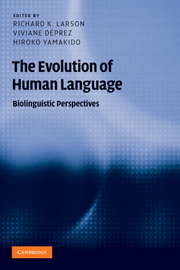Book contents
- Frontmatter
- Contents
- Figures
- Contributors
- Acknowledgments
- Introduction
- 1 The faculty of language: what is it, who has it, and how did it evolve?
- Part I Language architecture
- 2 Some simple evo devo theses: how true might they be for language?
- 3 Your theory of language evolution depends on your theory of language
- 4 Three meanings of “recursion”: key distinctions for biolinguistics
- 5 On obfuscation, obscurantism, and opacity: evolving conceptions of the faculty of language
- Part II Language and interface systems
- Part III Biological and neurological foundations
- Part IV Anthropological context
- Notes
- References
- Index
4 - Three meanings of “recursion”: key distinctions for biolinguistics
Published online by Cambridge University Press: 05 June 2012
- Frontmatter
- Contents
- Figures
- Contributors
- Acknowledgments
- Introduction
- 1 The faculty of language: what is it, who has it, and how did it evolve?
- Part I Language architecture
- 2 Some simple evo devo theses: how true might they be for language?
- 3 Your theory of language evolution depends on your theory of language
- 4 Three meanings of “recursion”: key distinctions for biolinguistics
- 5 On obfuscation, obscurantism, and opacity: evolving conceptions of the faculty of language
- Part II Language and interface systems
- Part III Biological and neurological foundations
- Part IV Anthropological context
- Notes
- References
- Index
Summary
Introduction
There has recently been a resurgence of scientific interest concerning the importance of various types of phrase structure in human language, and their potential presence in other species (Hauser, Chomsky, and Fitch 2002; Fitch and Hauser 2004; Everett 2005; Fitch, Hauser, and Chomsky 2005; Pinker and Jackendoff 2005; Gentner et al. 2006). Following Hauser, Chomsky, and Fitch (2002, HCF hereafter), many of these recent discussions have used the term “recursion,” but the term has rarely been defined explicitly. There are several possible interpretations of this word, which is used somewhat differently in different disciplines, without there being one universally accepted scientific definition. With the recent advent of intense inter-disciplinary discussion of these issues, it has become clear that several different interpretations of the term are being used interchangeably. We seem to have reached a point where serious misunderstandings are in danger of propagating through the literature. The main purpose of this paper is to clarify these different meanings, and in the process to examine the implications of recent and ongoing experiments for different types of grammars in animals and humans.
My main research interest is in understanding the types of rules that structure acoustic signals and cognition in a wide variety of different vertebrate species, with the hope that this will provide a better basis for understanding the biology and evolution of the computational subsystems involved in human language.
Information
- Type
- Chapter
- Information
- The Evolution of Human LanguageBiolinguistic Perspectives, pp. 73 - 90Publisher: Cambridge University PressPrint publication year: 2010
Accessibility standard: Unknown
Why this information is here
This section outlines the accessibility features of this content - including support for screen readers, full keyboard navigation and high-contrast display options. This may not be relevant for you.Accessibility Information
- 8
- Cited by
